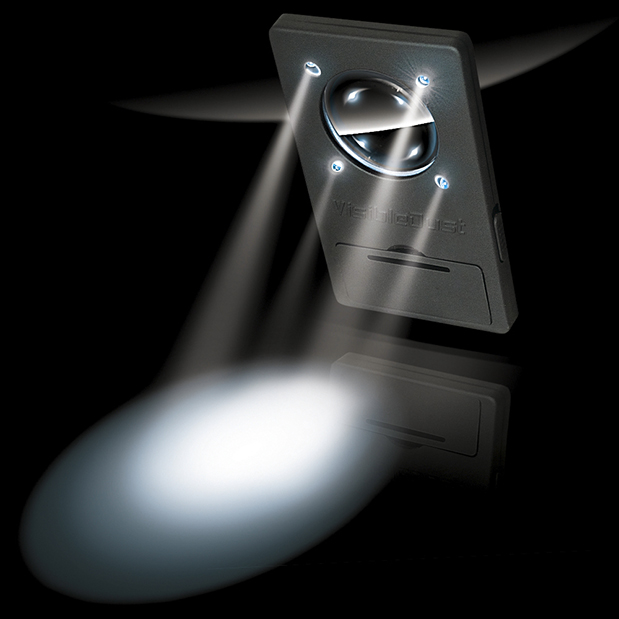
The mini Quasar is a loupe with battery powered LED lights that aids three ways in camera sensor inspection. First to identify the tiniest of errant particles before cleaning, to make sure you didn’t leave a smear, and then to save time and trouble by confirming that further cleaning is unnecessary. This little gem should make it possible for even me to see junk on the sensor.
When Karl first discovered VisibleDust products, he was so pleased with the results he bought a kit for several of our friends and told many others at convention about them. Many of these people combat serious conditions for commercial or editorial work. Climbing, surfing, auto racing, landscapes where wind and weather are factors.
We all know that dust and particles can just make you crazy with time consuming postproduction required to eliminate them. Self maintenance pays huge dividends. Most of us simply don’t have the time, much less funds, to send in equipment for factory service. When you need it you need it. And you need to know you did it right. Sensor cleaning is Karl’s surgical chore, because I have trouble seeing the dust particles and the haze you can get from smearing when you clean. Dare I say, Karl has just the right touch?
VisibleDust has solutions for both wet and dry cleaning. Karl wants to emphasize the difference. Loosely explained, dry cleaning, with the predominantly negative-ion generating Zeeion blower and the Arctic Butterfly anti-static brush are more for fast, on-location use. The wet systems should not be used out on the job, but when you return to base and have some control over wind, humidity and temperature. Wet is best, and VisibleDust provides various surgical quality swabs and liquids to clean the sensor, the inside of the housing, lenses themselves and one more to help minimize smears. Karl keeps all his VisibleDust materials in a tight-sealed plastic box, because our Western US climate is high, dry, and we’re very prone to dust creeping in everywhere. We recommend having both wet and dry cleaning tools on hand.
Arctic Butterfly Kit with Zeeion blower
2 main liquid types with sensor-sized swabs
I push a lot of pixels through my cameras. News and event photographers do more yet. Over time, not just conditions, the predominantly positive electrical charge inside cameras can’t help but suck in particles to land and stick on the sensor. In really awful conditions, some photographers tape their equipment and don’t change lenses or media. It’s always been good advice to keep lens front and back caps in place, and in cases until you’re on location ready to work. I try to be really careful with lenses, and change them quickly in protected conditions. But at some point you’ve gotta have your equipment out there, instantly really to work as the action develops in front of your camera. And it’s really a good idea now and again to neutralize that sucky positive charge inside your camera by using the VisibleDust products.
The Canon 5D Mark II with it’s innovative sensor cleaning automation decreased my cleaning needs dramatically. By my informal estimate, auto cleaning now does about 80% of the cleaning I need for the types of jobs I do, but that does not mean that my sensors are pristine. I’m usually in pretty clean locations, and more important, I am almost always working at very low ‘ numbers. ‘/5.6 is really a lot of depth of field for me! Therefore unless my sensor is alive with a really obnoxious chunk of dust or squiggly thread, I’d hardly see it, because it’s totally out of focus. Maybe just a bit of haze or a dull, furry spot in blank sky. I’ve really skated by with a relatively sheltered photographic existence.
mini Quasar shows dust and particles clearly defined
Even if cleaning for me is a “honey-do” thing, I really want to know when to beg for help. That’s where for me the optical glass mini Quasar comes in. The magnifier fits right over the lens mount, and is tooled to focus at the exact right distance to the sensor. But wait, there’s more! Why LED lights and not just a good loupe? Well, you have to see down in the dark hole of the camera lens mount/mirror/sensor area, and that’s pretty hard to do if you have your face right on top of the unit. The mini Quasar’s four LEDs are extra bright and positioned at angles, which orientation helps to pin point those elusive dust particles by focussing right on the sensor surface. it’s so easy to recheck you haven’t left a streak or water spot or haze to compound the problem.
More information and lots of tutorials at http://www.visibledust.com/
